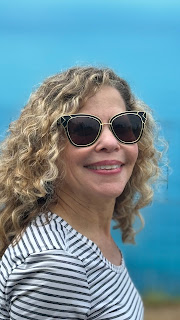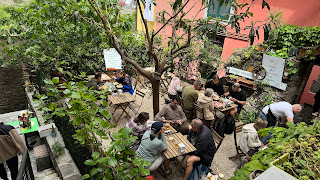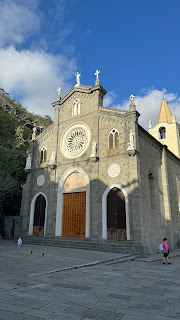Make no mistake about it, Cinque Terre is a serious hiking destination, rivaling any American National Park we have visited. The previous days rains are gone and all the trails are open. We’re caffeinated, fed, layered up, geared up and out the door by 9am. First hike is Riomaggorie to Manarola, and the trail head is just a 5 minute walk (uphill of course) from our front door. Just before we start the trail we see a little stream bed, usually just a trickle of mountain water, which today has been transformed to a raging deluge from all the rain. It’s a harbinger of the trek to come.
The initial section of the trail is an unrelenting flight of
620 uneven “stairs”, many taller than they are wide, covering a 700’ vertical
rise in about half a mile. About a
quarter of the way up we stop to lose some layers and meet two fellow hikers
from Salt Lake City. The women are friendly
and we chat a bit about the their plans and ours before moving on. As we ascend, we get great views of Riomaggorie,
stopping frequently to take pictures, take a sip of water or just catch our
breath. We end up hopscotching with the
women from Salt Lake, who are doing the same thing, chatting with them more
each time. At one point one of the women
says to us that they have only ever met nice people when they travel and
hike. Hmmmmm, twice in two days… must be
something to this.
We are flat out exhausted by the time we reach the top, but
as any hiker knows, up may be more effort, but down is harder. This is especially true when the footing on
the downhill is extremely uneven and slippery.
We’re stepping as carefully as we can when we get our first views of
Manarola, and we both release an involuntary, simultaneous gasp of “wow” which
makes us laugh out loud. Looking ahead,
we get a great perspective of the tiers built into the mountains. Starting thousands of years ago, the inhabitants,
using donkeys and burlap sacks and sheer willpower, moved millions of stones to
make thousands of retaining walls. These
walls transformed the inhospitable mountainside into a network of flat rows that
were suitable for subsistence farming. This
same network is still in use today, and we see swatches of lemon and orange
trees, vegetables, berries and, of course, wine grapes. From this vantage point, Manarola is a stone
drop in a pond, the tiers rippling outwards disrupting the calm surface of the
land.
We are sweaty and muddy as we make Manarola around 11, but
the happy sunshine and sense of accomplishment have us convinced we can just
keep hiking all day. The trail ends just
a few yards from the enoteca we hung out in yesterday, and across the courtyard
there’s a café where we wash up and get some rich cappuccino with a couple petite,
crispy Nutella filled cookie sandwiches we can only describe as Italian
macrons. The rest of the village is
another 100’ below us, but instead of heading down, we head to the start of the
trail to Vernazza. This is a longer
trail then the first, with a higher total elevation gain, but isn’t quite as
punishing because the climb is over a longer distance. It's not to say it’s not steep. It is.
It’s not to say it’s not challenging.
It is. At one point during the ascent,
when some clouds blot out the sun, I am very conscious of my mood change and
can’t help but wonder if we bit off more hiking then we can chew. Thankfully my optimism returns with the
sunshine and we push on to Volastra, the village at the 899’ summit of the
trail. About Volastra. Cinque Terre is a bit of a misnomer. It does refer to the five villages that are
closest to the sea and most accessible because their connected by the rail line,
but there are dozens more little burgs dotting the mountains here just a little
further up. Volastra is one of those
villages, replete with its own shops and the mandatory village church, still
the cultural hub for places like this.
Not too far out of the village, right on the trail, we run
into Agrivino, the “tasting room” at Cantina Capellini, not much more then a
concession stand with a grill serving made-here wine and bruschetta on homemade
bread with grown-here tomatoes. We are
absolutely, 100% stopping here. I order
us two glasses of the white and we sit on crates next to a makeshift table
overlooking the Ligurian Sea. It is
simplistic elegance at its finest. We
start talking to the people who sit next to us a couple from Wisconsin about
our same age. Five minutes into the
conversation the man says how nice everybody they meet is when they travel despite,
or maybe even because of, the diversity of their backgrounds and views. As if on cue, the two women from Salt Lake
appear on the trail right in front of us (I would have sworn they were way
ahead of us by this point), and I introduce the nice people to the other nice
people and we all have a nice moment with a nice glass of wine and a nice
view. It was, well, nice. Also, it is exactly why we travel like we
do. Salt Lake presses on, and we sit
finishing our glasses and taking way too many pictures, intent on capturing this
feeling in the moment.
The descent into Corniglia is long and brutal. Our joints are screaming, the trail is treacherous,
the footing unnerving and we’re just loving it.
Finally making town we treat ourselves to the massive lunch we’d been
discussing for the last 45 minutes.
Trofie pasta with pesto, a focaccia sandwich, big arugula salad, with a
rehydrating limoncello spritz for Mandy and cold pint for me.
After lunch we train it to Monterosso in search of a piece
of ceramic art Mandy had seen in our previous visit. It’s a hand glazed blue puffer fish and a
nice representation of the ceramic arts of the area, plus it’ll go nicely at our
place at the shore. It’s there I find my
namesake hotel, and I just can’t help mugging for the camera.
Back at our place, we sip some wine on the balcony and enjoy
the late afternoon sun. We leave for
dinner early as we realized we haven’t explored our own village much at
all. It may be the most beautiful of the
5 and has a very relaxed atmosphere. As
the sun fades into long shadows, we find a tiny café halfway up a narrow staircase,
maybe half a dozen tables inside and the same number out. We pick a seat inside as the night cool blows
in and I get a good view into the kitchen.
It doesn’t take long to realize that our server and the chef are a married
couple who own the restaurant. The highlight
of the meal is a traditional Ligurian dish made with a very regional “spongy
pasta” that’s cut into 4” squares. When
I mention to the server that it reminds me of Pennsylvania Dutch dumplings, she
goes on to explain that her father is German and there is quite a bit of German
influence in the regional food. As we
leave, we see the owner/chef and his sous chef sitting outside having a smoke
after a busy service, and we spend a minute chatting and to thank them for a
nice final meal in Cinque Terre.












































No comments:
Post a Comment